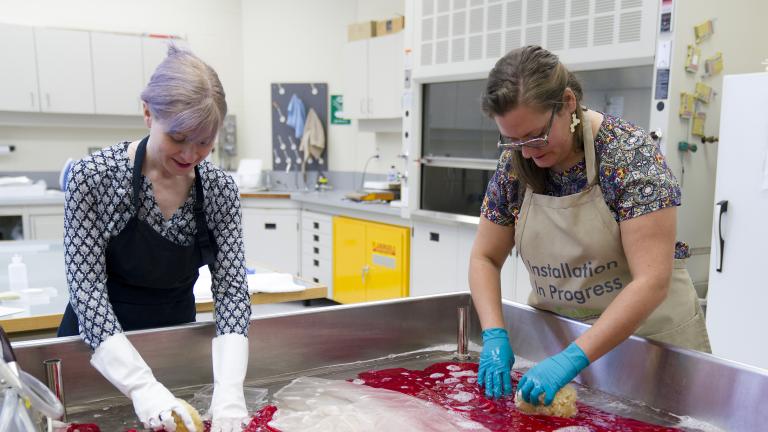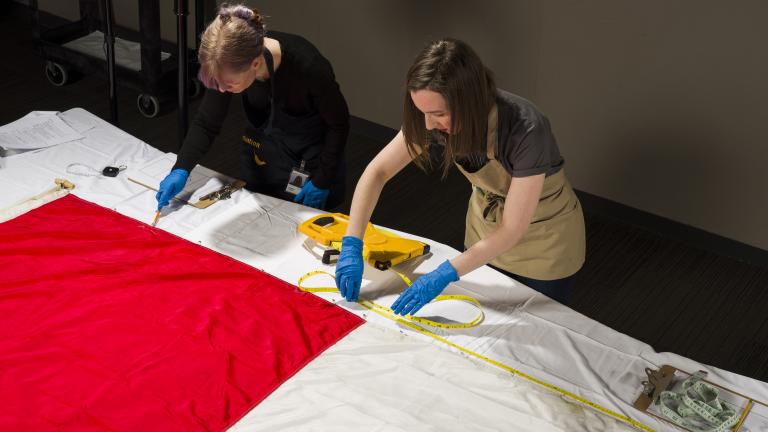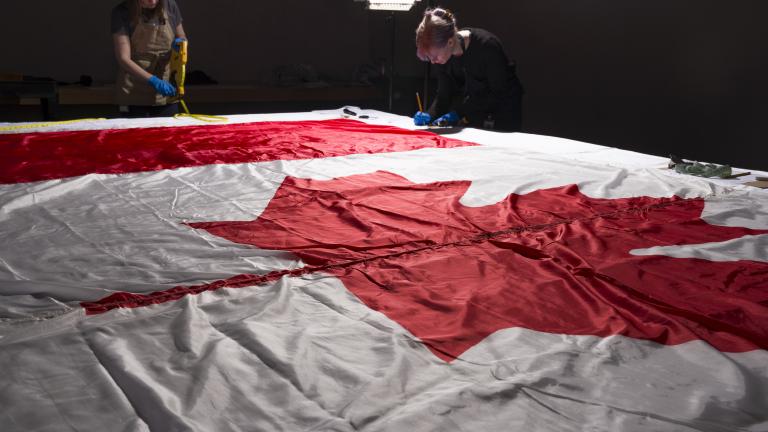If you’ve ever visited the nation’s capital, you’ve surely seen it: perched atop the Peace Tower on Parliament Hill in Ottawa, a huge Canadian flag flutters above the ornate legislative buildings with green copper roofs. Every weekday, the flag is changed and a new one is raised. The Museum’s collection now includes the flag that flew atop the Peace Tower when equality rights received constitutional protection for the first time.
The fight for equal rights in Canada
Preserving a symbol of Canada’s human rights history
By Rémi Courcelles
Published: April 13, 2020
Tags:
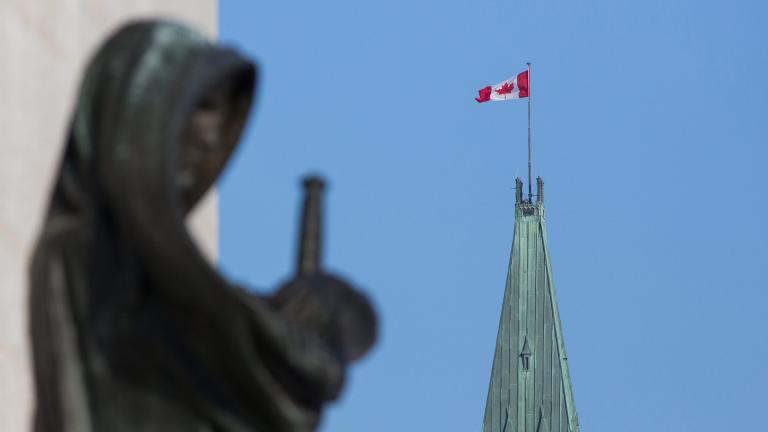
Photo: Canadian Press, Lars Hagberg
Story text
On April 17, 1985, section 15 of the Canadian Charter of Rights and Freedoms came into effect. All people in Canada were finally explicitly equal before and under the law. This story is about what led to that landmark day for human rights in Canada, and the people who made it happen.
Disability and women’s rights advocates, Indigenous leaders and representatives of various ethnic and religious communities came forward to fight for better rights protections.
People with disabilities were initially excluded from section 15, and disability rights activists and organizations fought hard to be included in Canada’s new constitutional protections. David Lepofsky was involved in this struggle through his advocacy work with the CNIB. With scant resources, little notice, and while studying for his bar exams, Lepofsky prepared and delivered a key presentation to the House of Commons committee responsible for constitutional reform. And, when it looked like disability protections would not be included in the new law, he took his message to the media.
Video: David Lepofsky
Women’s rights organizations also lobbied the government for stronger guarantees, as the 1970s saw more and more women taking action and raising awareness about their lack of rights. When the federal government cancelled an official conference of the Canadian Advisory Committee on the Status of Women to discuss possible Charter amendments for women’s rights, telling organizers not to worry and they would “look after things,” women leaders were not convinced their voices would still be heard. Together, they formed the Ad Hoc Committee of Canadian Women on the Constitution and decided to hold the meeting anyway.
And so, on February 13 and 14, 1981, more than 1,000 “Ad Hockers,” as they came to be known, from across the country descended on Parliament Hill to discuss the amendments and ensure equality rights would be constitutionally protected, capturing national attention. One of the conference organizers was the Honourable Marilou McPhedran, who was named to the Order of Canada for her efforts and was later appointed to the Senate of Canada.
Video: Senator Marilou McPhedran
Thanks to the dedicated efforts of activists like Senator McPhedran and David Lepofsky, along with the many other organizations who spoke up for equal rights, section 15 of the Canadian Charter of Rights and Freedoms was amended to provide better guarantees to every person in Canada. The clause was also renamed from “Non‐discrimination Rights” to “Equality Rights” to reflect that true equality goes beyond simple non‐discrimination. Today, section 15 reads as follows:
Equality Rights
15(1) Every individual is equal before and under the law and has the right to the equal protection and equal benefit of the law without discrimination and, in particular, without discrimination based on race, national or ethnic origin, colour, religion, sex, age or mental or physical disability.
(2) Subsection (1) does not preclude any law, program or activity that has as its object the amelioration of conditions of disadvantaged individuals or groups including those that are disadvantaged because of race, national or ethnic origin, colour, religion, sex, age or mental or physical disability.
A moratorium on section 15
The new Charter of Rights and Freedoms came into effect on April 17, 1982. Its main purpose was to ensure that discriminatory laws could no longer be passed without the risk of these laws being seen as unconstitutional by the courts. While some opposed this move as limiting the powers of Parliament, many others celebrated it as a necessary step in guaranteeing that the rights and freedoms of all people would be protected from government abuse. In the end, fundamental rights and freedoms were entrenched into the constitution, adding important legal barriers against arbitrary use of state power.
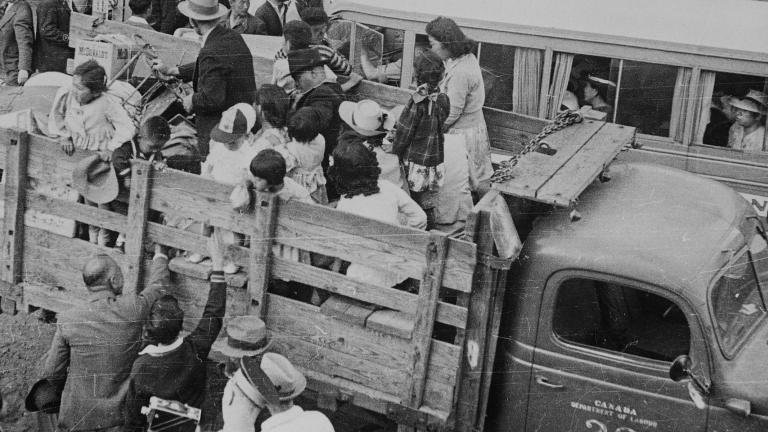
During constitutional negotiations, all levels of government feared being found in contempt of the equality clause due to its far‐reaching implications for existing policies and legislations. For this reason, the federal government decided to place a three‐year moratorium to delay the clause’s coming into effect. This was to give federal, provincial and territorial governments the time to review their policies and legislation and make any necessary changes. Section 15 came into effect on April 17, 1985, exactly three years after the Charter of Rights and Freedoms first came into force.
Discrimination cases filed immediately
On the same day the equality clause came into effect, the Women’s Legal Education and Action Fund (LEAF) launched three separate legal challenges to discriminatory government practices using section 15. LEAF was co‐founded by a group of women that included Senator McPhedran, as well as the Honourable Senator Nancy Ruth, who worked alongside her as one of the leaders of the Ad Hoc Committee of Canadian Women on the Constitution.
It was important to continue to hold our governments accountable and it was important to expose the governments that were lying about what they were and were not doing (to come into compliance with the Charter).
Because of the critical role Senator Nancy Ruth played in bringing about the equality clause, the flag that flew on the day section 15 came into effect was offered to her as a gift. Senator Nancy Ruth donated the flag to the Canadian Museum for Human Rights for preservation in 2018.
Conserving a symbol of equality
When the Museum received this symbolic flag, it came in a wooden presentation box. The Museum’s registration and conservation staff inspected the large flag to determine what would be needed for long‐term preservation. With help from Parks Canada, Museum staff washed the flag with non‐corrosive detergent to prevent degradation.
It’s rare to receive something as large as this flag. It actually drew a crowd of Museum staff and volunteers who wanted to see this special piece of Canadian human rights history.
The flag is now kept in climate‐controlled storage, away from damaging light exposure. The flag will occasionally be displayed to Museum visitors to help ensure that the story of equality rights in Canada continues to be told.
A symbol that will live on
It’s not every day that a constitution is revised or rewritten. In moments like these, it is often those directly affected by unjust legislation or whose rights have been curtailed who come forward to lobby for better protections.
Between 1980 and 1982, thousands of individuals and organizations stepped forward to demand better rights protections. Thanks to their efforts, the Canadian Charter of Rights and Freedoms ensures that our rights and freedoms are guaranteed equally under the Constitution.
Although the Charter had been in effect for three years already, April 17, 1985 was the first day in Canadian history that all people in this country were constitutionally treated as equal. The Canadian flag that flew on Parliament Hill that day will live on as a symbol of equal rights for generations to come. The Museum is honoured to help make sure of it.
Ask yourself:
Where do I see discrimination in my community?
What action can I take to ensure equality for all?
What is the role of museums in preserving key symbols for the future?
Suggested citation
Suggested citation : Rémi Courcelles. “The fight for equal rights in Canada.” Canadian Museum for Human Rights. Published April 13, 2020. https://humanrights.ca/story/fight-equal-rights-canada

